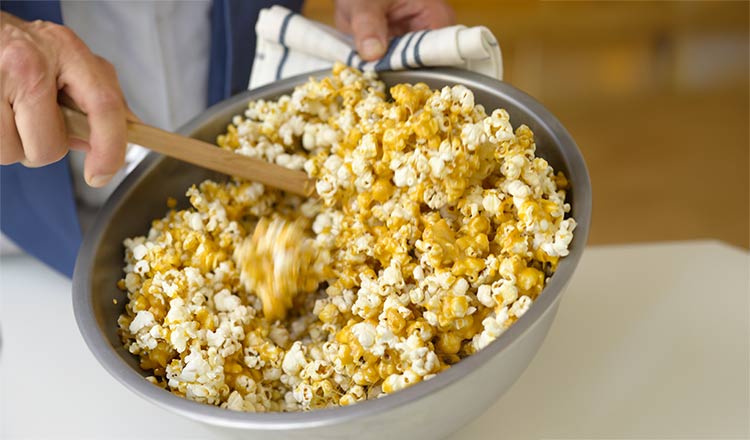Caramel-coated popcorn, or a popcorn-nut mixture, is a simple-to-make, delicious treat involving little more than caramelizing sugar, adding flavorings, and stirring together with the popcorn mixture. Although caramel corn is often enjoyed almost immediately, it can be stored for longer periods when it is wrapped to protect it from humidity (and eager hands!).
What’s In It?
WATER
As always when cooking sugar, water is used to dissolve the sugar. In the case of caramel corn, virtually all the water is removed during cooking to create a crisp texture.
SUGAR
Sugar provides the sweetness and the coating for the popcorn. In this process, the sugar is caramelized.
BROWN SUGAR
In addition to sweetness, brown sugar contributes molasses flavor and additional browning to caramel for popcorn.
CORN SYRUP
Corn syrup helps to prevent the recrystallization of sugar.
BUTTER
Butter not only adds flavor and contributes to a more tender bite, but also helps to prevent the pieces in the mixture from sticking together.
SALT
Popcorn (and nuts) without salt are just incomplete to most people, even when coated with caramel.
BAKING SODA
Baking soda aerates caramel, giving it a more delicate bite. It also promotes browning and flavor development.
POPCORN
This is the center to be coated with the caramel mixture. Any other type of center can be added, provided it is dry (so as not to dissolve the caramel) and is firm enough to stand up to the stirring required to coat it with the caramel. Some other suggested centers include nuts, cereals, seeds, crackers, and pretzels.
How It’s Made
Making this popular treat is a simple matter of caramelizing sugar and mixing in the popped corn, followed by butter. Once the popcorn is coated with caramel, the individual kernels are separated by hand and allowed to cool until they are no longer sticky.
Because you are working with hot sugar, extreme caution must be exercised when handling the sugar; gloves, whether rubber or leather, must be worn for this part of the process. Should the caramel corn become too cool to separate, it can be rewarmed in a 250°F oven to soften it so that the process can be completed.
- Combine the popcorn and nuts and place in a 250°F oven to keep warm.
- Combine the sugars and water and cook to 300°F to begin caramelization.
- Mix in the salt.
- Add the baking soda to the sugars off the heat.
- Add the caramel to the warm popcorn. Stir until the corn is coated with the caramel, reheating as necessary.
- Add the butter to the batch and mix lightly.
- Pour the mixture onto an oiled countertop or sheet pan, and while it is still warm, separate into individual kernels.
How It’s Stored
Caramel-coated popcorn has a good shelf life, provided it is protected from humidity. The finished treats should be sealed tightly in airtight containers as soon as they have cooled to prevent damage from moisture in the air.


